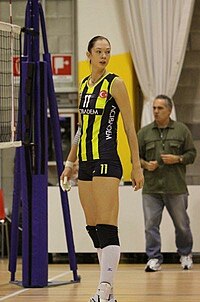
Photo from wikipedia
The aim of the study was to determine the effects of proprioceptive training (PT) on balance, strength, agility and dribbling in adolescent soccer players. In this research, we included an… Click to show full abstract
The aim of the study was to determine the effects of proprioceptive training (PT) on balance, strength, agility and dribbling in adolescent soccer players. In this research, we included an experimental (n = 48) and a control (n = 48) group (CG) with 14 years old players. The experimental group (EG) participated in an 8 week PT program, with four 30 min sessions per week. The experimental program included 12 bosu ball exercises to improve balance, stability and strength which were grouped into two subprograms: the first not using the soccer ball, the second subprogram using the soccer ball. The subprograms were implemented alternately during 16 proprioceptive training sessions, on two types of firm and foam surfaces. Pre- and post-tests included the static balance [Balance Error Scoring System (BESS)], vertical, horizontal, and lateral jumping, and the completion of agility (“arrowhead”) and dribbling (“short dribbling”) tests. Regarding the total BESS score, the CG has demonstrated progress between the pre- and the post-test, with 0.780 ± 0.895, fewer errors, while the EG had 5.828 ± 1.017 fewer errors. The difference between the two groups was of 5.148 fewer errors for the EG who had practiced the proposed program of proprioceptive training. The highest difference registered between the pre- and the post-test was at the test “single-leg forward jump with the right leg”, with a result of 1.083 ± 0.459 cm for the CG and of 3.916 ± 0. 761 cm for the EG. Through the analysis of average differences between the pre- and the post-tests, we observe that, regarding the “Agility right side test”, the EG has progressed with 0.382 s in comparison with the CG; regarding the “Agility left side test”, the EG has progressed with 0.233 s compared to the CG; regarding the “Agility right and left side test”, the EG has progressed with 0.196 s compared to the CG; in the “Short dribbling test”, the EG has progressed with 0.174 s compared to the CG. The highest progress was made at the “Agility right side test”, of 0.402 s for the EG, while the CG registered 0.120 s. Most of the results in all tests for both experimental groups show an effect size ranging from small to medium. The progress made by the experimental group in all tests was statistically significant, while in the control group the progress was mostly statistically insignificant for p < 0.05. The results suggest that a PT program performed at about 14 years of age could be successfully implemented in the training regime of soccer players to improve components of fitness along with dribbling skills. The results of the study revealed that sports training on the foam surfaces determined a superior progress of the development of proprioception compared to the increased training on the firm surfaces.
Journal Title: International Journal of Environmental Research and Public Health
Year Published: 2022
Link to full text (if available)
Share on Social Media: Sign Up to like & get
recommendations!